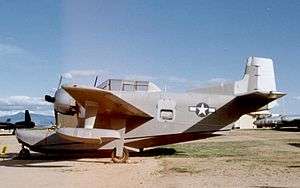Columbia XJL
| XJL-1 | |
|---|---|
 | |
| The third Columbia XJL-1 preserved at the Pima Air Museum near Tucson, Arizona, in February 1993 | |
| Role | single engine amphibian |
| National origin | United States |
| Manufacturer | Columbia Aircraft Corporation |
| Designer | Grumman Aircraft |
| Introduction | 1946 |
| Status | one flying in civil use; one preserved |
| Primary user | U.S. Navy and civil owners |
| Number built | 3 |
| Developed from | Grumman J2F Duck |
The Columbia XJL was a large single-engined amphibian aircraft, designed by Grumman Aircraft but built by the Columbia Aircraft Corp. It was intended to replace the Grumman J2F Duck but the type did not reach production status.
Development

The Grumman J2F Duck biplane amphibian had successfully served the United States Navy (USN) in quantity from late 1934 onwards. The final 330 examples were built in 1941/42 under sub-contract by the Columbia Aircraft Corp, retaining the J2F-6 designation.[1]
At the end of World War II, Grumman completed a major re-design of the aircraft for the USN as a Wright R-1820-56 powered monoplane amphibian. The new design was turned over to the Columbia Aircraft Corporation for development and construction so that Grumman could focus on the production of fighter aircraft for the USN.
The aircraft strongly resembles the J2F Duck, except for its monoplane layout, and has been referred to as a "single-winged Duck". It is, however, a completely new design.
Production
The USN ordered three XJL-1 experimental aircraft from Columbia, with the first being used for destructive strength testing on the ground. The remaining two airframes, assigned USN BuAer Nos 31399 and 31400, were delivered to the USNs test establishment at Patuxent River Naval Air Station Maryland for evaluation in 1946.
Operational history
The two aircraft tested at Patuxent River were found to have repeated structural failures of various components and testing was abandoned on 21 September 1948. The aircraft were deleted from the USN inventory in February 1949.[2] No further orders were placed for production of the JL design.
Specifications
Data from Plane Facts: Monoplane "Duck"[3]
General characteristics
- Crew: 2
- Capacity: 6 passengers
- Length: 45 ft 11 in (14.00 m)
- Wingspan: 50 ft 0 in (15.24 m)
- Height: 16 ft 0 in (4.88 m)
- Wing area: 413 ft2 (38.37 m2)
- Empty weight: 7,250 lb (3,288 kg)
- Gross weight: 13,000 lb (5,897 kg)
- Powerplant: 1 × Wright R-1820-56, 1,350 hp (1,007 kW) each
Performance
- Maximum speed: 200 mph (322 km/h)
- Range: 2,070 miles (3,330 km)
- Rate of climb: 1,110 ft/min (5.6 m/s)
See also
- Aircraft of comparable role, configuration and era
- Related lists
References
Citations
Bibliography
- "Plane Facts: Monoplane "Duck"". Air Enthusiast. Vol. 3 no. 5. November 1972. pp. 261–262.
- Swanborough, Gordon (1990). United States Navy Aircraft since 1911. Naval Institute Press. ISBN 0-87021-792-5.
External links
| Wikimedia Commons has media related to Columbia XJL. |